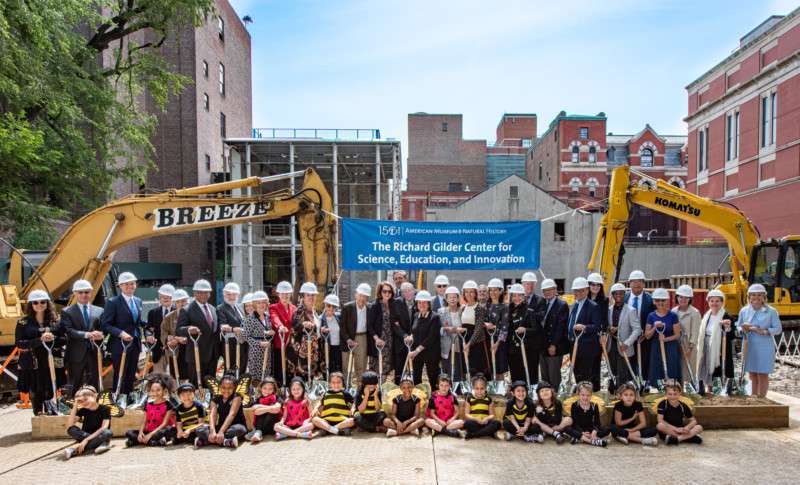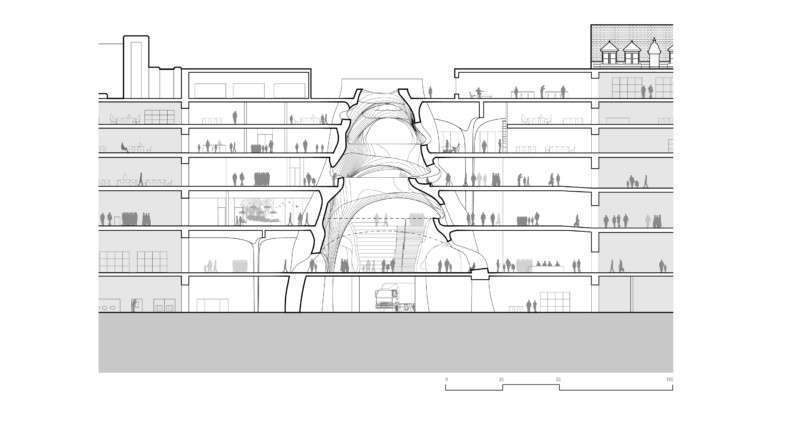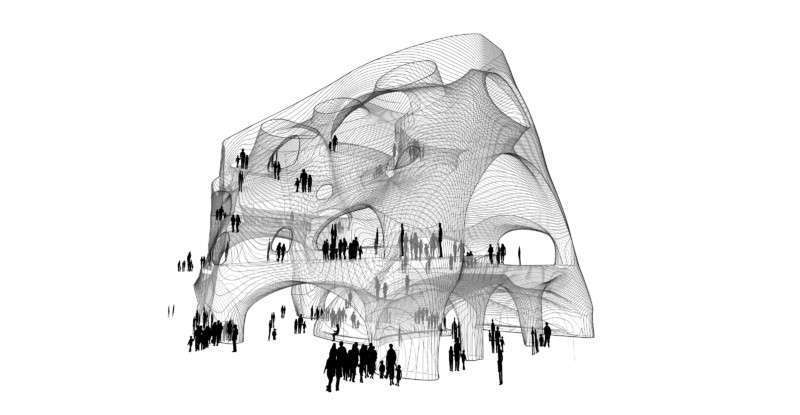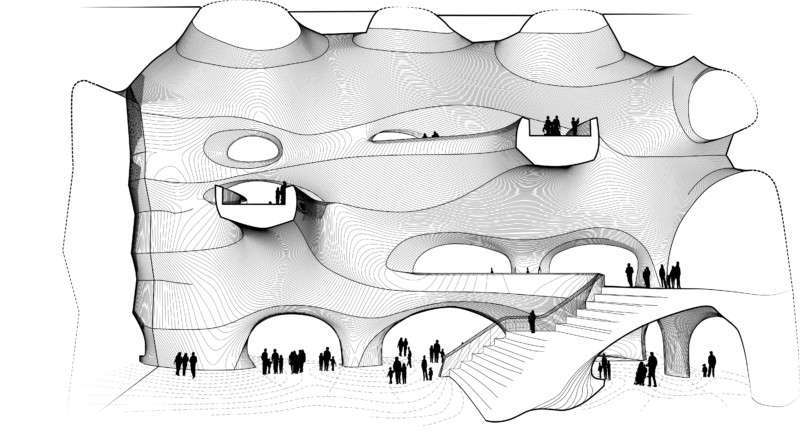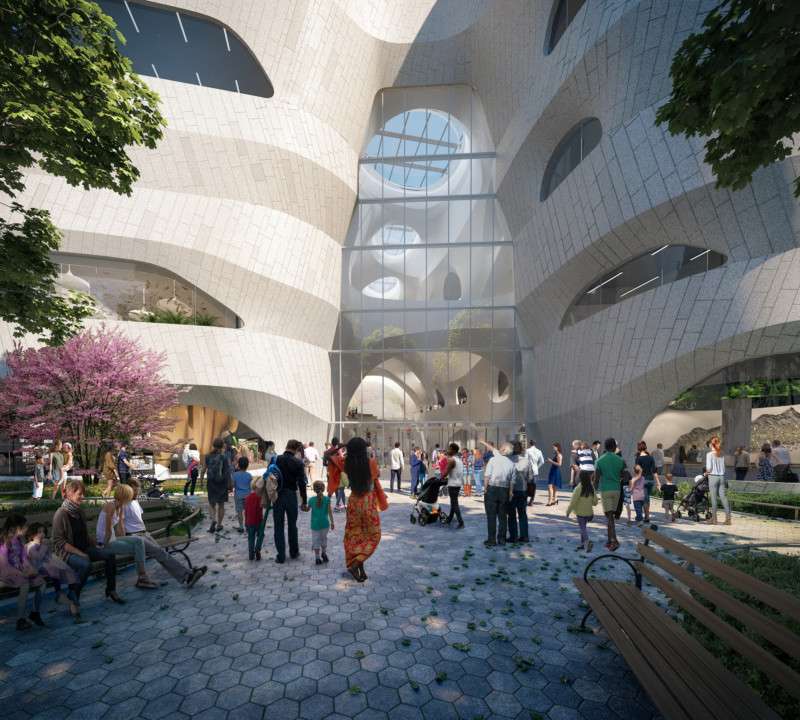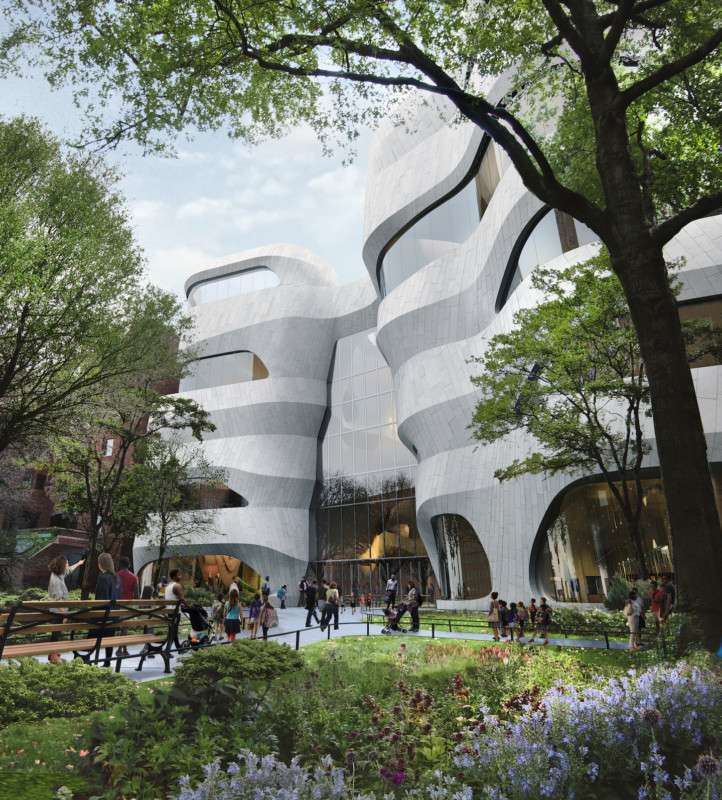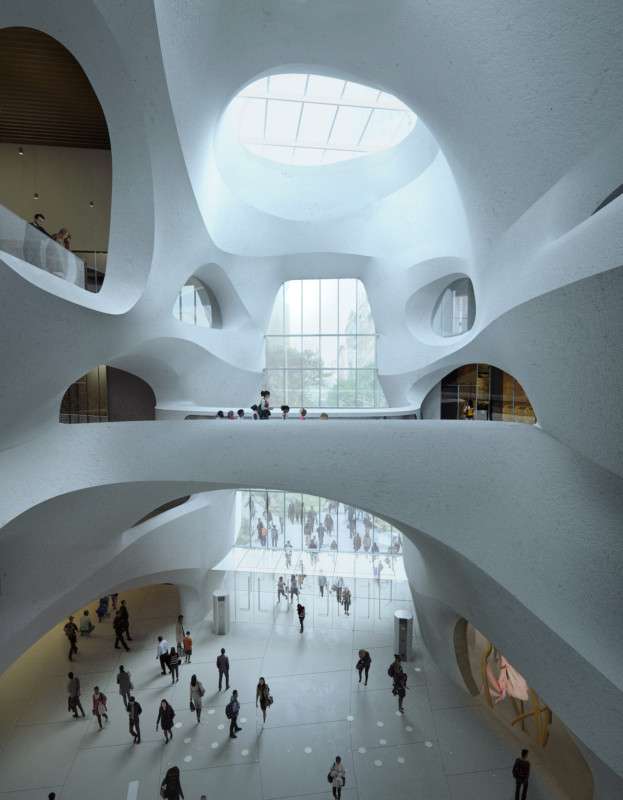June 12, 2019 — The American Museum of Natural History (AMNH) in New York City today broke ground on the Richard Gilder Center for Science, Education, and Innovation, the new facility that will add exhibition galleries, state-of-the-art classrooms, an immersive theater, and a redesigned library, reveal more of the Museum’s scientific collections, and link 10 Museum buildings to improve visitor flow throughout the campus.
A groundbreaking ceremony for the 230,000-square-foot, $383 million project brought together Chairman of the Museum’s Board of Trustees Lewis Bernard; Museum President Ellen V. Futter; New York CityMayor Bill de Blasio; Museum Trustee Richard Gilder, for whom the building is named; Manhattan Borough President Gale A. Brewer; officials from many of the more than 10 City agencies involved with this project, including Commissioner of Cultural Affairs Tom Finkelpearl, New York City Department of Parks and Recreation Commissioner Mitchell Silver; and Museum Trustee and Chair of the Buildings and Grounds Committee Valerie S. Peltier. Architect Jeanne Gang of Studio Gang—a MacArthur Fellow who was named one of TIMEmagazine’s 100 most influential people of 2019—and exhibit designer Ralph Appelbaum of Ralph Appelbaum Associates also participated in the celebration. Ramon Pimentel, a graduate of the Museum’s Science Research Mentoring Program and a sophomore at SUNY College of Environmental Science and Forestry, as well as a delegation of New York City schoolchildren representing hundreds of thousands of young students who visit and learn at the Museum each year and will benefit from the Gilder Center, also joined the celebration.
Featuring architectural forms inspired by natural Earth processes, the Gilder Center will introduce visitors of all ages to current research through cutting-edge exhibitions and innovative education programs in dedicated learning zones. With new exhibitions that include a multi-story glass-walled Collections Core housing approximately 4 million scientific specimens, the Gilder Center will for the first time allow Museum visitors to see into working collections areas, revealing and underscoring the physical evidence that underpins scientific knowledge. For the Gilder Center, the Museum will seek a LEED (Leadership in Energy and Environmental Design) Gold certification—a globally recognized symbol of sustainability achievement—by deploying a range of innovative design strategies to reduce waste and conserve energy.
Construction of the Gilder Center has started during the Museum’s 150th anniversary celebration, which began officially in March 2019. During the multi-year anniversary period, the Museum will realize a range of physical and programmatic initiatives inspired by a legacy of scientific exploration and education that serves as a crucial conduit between science and society. These initiatives will elevate every aspect of the Museum’s activities, from engaging visitors in the wonders of the natural world to raising awareness about critical issues such as biodiversity and climate change to ensure that the Museum can continue to nourish the curiosity of generations of New Yorkers and millions of visitors from around the world onsite and online. Capping the 150th anniversary initiatives will be the opening of the Gilder Center.
FROM THE GROUNDBREAKING CEREMONY
“The Museum was chartered by the State of New York in 1869 as an educational institution, and education is at the core of our being,” said Lewis W. Bernard, Chairman of the American Museum of Natural History. “The Gilder Center will advance the way we conduct science and our collections are presented, in addition to housing a great library and offering new approaches to education.”
“This spring, the Museum kicked off its 150th anniversary commemoration, celebrating our mission in science and education, highlighting our commitment to New York City, and underscoring the Museum’s lynchpin role in bridging science and society,” said Ellen V. Futter, President of the American Museum of Natural History. “Today, we are delighted to break ground on the new Gilder Center for Science, Education, and Innovation, which will extend and continue the Museum’s longstanding mission of civic service. We salute the partnership of visionary supporters, from both the public and private sectors, that has made this exciting project possible.”
“For 150 years, the American Museum of National History has reigned as one the greatest cultural and scientific institutions in the world,” said New York City Mayor Bill de Blasio. “In addition to the Museum’s outsized conservation efforts, it has also become a place of joy and exploration for children around the world. The City’s investment in the Gilder Center project will enable the Museum to provide enrichment programs to more children and share more of its vast collection with the public.”
“One of the hallmarks of great cities throughout history has been the strength and vitality of its institutions of learning and culture, perhaps nowhere more so than New York City, with its great parks, museums, and libraries,” said Museum Trustee Richard Gilder. “Among them, the American Museum of Natural History has long been a driver of our City’s vibrant economy, educational achievement, and societal wellbeing. Now, in its sesquicentennial year, as the Museum launches this new facility, it proclaims a strong, clear vision for the future of our City and our global community. I am honored to be part of this new Center and the Museum’s next chapter of excellence.”
“Our design for the Gilder Center will invite visitors to explore the wonders of the Museum with its openness and smooth, flowing geometry,” said Studio Gang Founding Principal Jeanne Gang. “Through a network of new connections, people will be able to follow their own curiosity to discover treasures of natural history. This network is accessed through the Central Exhibition Hall, which utilizes the fluidity of concrete to create a porous structure and iconic interior.”
“Since it was established in partnership with the City in 1869, the American Museum of Natural History has set the bar for public science institutions. Today, it draws millions of visitors to its historic building here in New York, including hundreds of thousands of NYC public school students, while also conducting essential research around the globe into the natural world,” said New York City Department of Cultural Affairs Commissioner Tom Finkelpearl. “We are proud to continue this historic partnership by investing in this extraordinary new facility. The Gilder Center will provide a cutting-edge space to further the Museum’s core mission of providing widely accessible public science education programming for residents and visitors. We look forward to watching this new NYC landmark take shape.”
“For 150 years, the American Museum of Natural History has made its home on City parkland, offering visitors from around the world a historical, educational experience,” said New York City Department of Parks and Recreation Commissioner Mitchell J. Silver, FAICP. “As a result of the Gilder Center expansion, Theodore Roosevelt Park will become more open, welcoming, and beautiful for all to use. We are grateful to the Museum for their partnership and look forward to seeing their vision for the Gilder Center become a reality.”
“The American Museum of Natural History is one of New York’s crown jewels—a place where people young and old, from all corners of the globe, come to learn about the origins of the world,” said New York City Economic Development Corporation (EDC) President and CEO James Patchett. “The Richard Gilder Center for Science, Education, and Innovation expansion is critical to the museum’s mission as a center for research and learning. The storied institution will continue to inspire current and future generations, and EDC is proud to play a role in bringing its new wing to life.”
“The Commission has a long history of working with the American Museum of Natural History, an individual and interior landmark, as they have adapted their complex to fulfill their mission to encourage and develop the study of natural sciences,” said New York City Landmarks Preservation Commission Chair Sarah Carroll. “Since its founding 150 years ago, the Museum has grown to meet its needs, and this is the latest generation in the evolution of this complex. Designed by Jeanne Gang of Studio Gang, the new building will be both a literal and abstract reference to the purpose of the Museum and to the forms, materials, and details of the other prominent buildings within this complex.”
“The American Museum of Natural History has long been a gem of New York City, full of learning opportunities for visitors of all ages,” said Manhattan Borough President Gale A. Brewer. “I’m thrilled for the addition of the Richard Gilder Center for Science, Education, and Innovation and congratulate all who played a role in the planning process of this magnificent space.”
“We should take a moment to remember the purpose of the Gilder Center—to promote scientific research and education for future generations of New Yorkers,” said Council Member Helen Rosenthal. “The Museum is an essential resource for all who are curious or committed to the growing body of knowledge about our natural world. New discoveries are made every day about subjects of profound importance, from human evolutionary development to the creation of our universe. We need space for our students, our residents, and people from all over the world to be able to learn, conduct research, and absorb that growing knowledge. The Gilder Center will be a great addition to this gem that we are lucky to have in our community.”
“The American Museum of Natural History is one of our city’s best and most innovative cultural institutions, and I am thrilled to see it expand with the Gilder Center for Science, Education, and Innovation,” said Council Member Jimmy Van Bramer, Chair of the Cultural Affairs and Libraries Committee. “The new Gilder Center will provide millions of New Yorkers with even more exhibition galleries and interactive learning spaces about the natural world to explore and discover. I am proud to support this project and excited to see all of the new scientific collections and research that will come from it.”
“We are thrilled, the Gilder Center will be an amazing addition to the Museum and our Upper West Side community,” said Roberta Semer, Chair of Manhattan Community Board 7. “The state-of-the-art educational facilities and new exhibit spaces are much needed. Our local merchants and restaurants join me in welcoming new visitors to our community—we can’t wait for opening day!”
“Friends of Roosevelt Park has been a steward of the 10-acre greensward surrounding the Museum for 25 years, having invested over $2 million in its ongoing maintenance,” said Peter Wright, President of the Friends of Roosevelt Park. “During that time, the Museum has been an exemplary neighbor, consulting with all local stakeholders on every initiative affecting the Park—starting with the Planetarium and garage in 2000, whose roof added 1 acre of green space and shallow water features ideal for young children. The much-needed Gilder Center includes an attractive, user-friendly redesign of its immediate park surroundings, created with the active involvement and support of our neighbors.”
“The Columbus Avenue Business Improvement District welcomes the most important addition to the Avenue in many years, with the groundbreaking of the magnificent Gilder Center,” said Barbara Adler, Executive Director of the Columbus Avenue Business Improvement District (BID). “The Museum has worked with the BID and the community to make this new Columbus Avenue portal an inviting and significant addition to Theodore Roosevelt Park, wide and welcoming for both visitors and our neighbors.”
“For 150 years, the American Museum of Natural History has been a haven of learning for New Yorkers and visitors from all over the world,” said New York State Senator José M. Serrano. “With its state-of-the-art exhibition and educational spaces, the new Gilder Center will advance the Museum’s proud mission of integrating scientific research, education, and exhibition, ensuring that it continues to be one of our city’s most beloved scientific and cultural institutions.”
“With the groundbreaking of the Richard Gilder Center for Science, Education, and Innovation, the American Museum of Natural History takes a giant step forward in realizing a grand educational vision,” said Assembly Member Linda B. Rosenthal (D/WF-Manhattan). “In addition to exceptional education opportunities to young students wishing to pursue STEM, I am confident that the Gilder Center will quickly become an important hub of cultural and community engagement. I look forward to a strong and continuing partnership with the Museum.”
“It is a wonderful moment to break ground on construction of the American Museum of Natural History’s Gilder Center for Science, Education, and Innovation,” said New York State Senate Minority Leader John J. Flanagan. “As Senate Republican Conference Leader, I know that it is imperative to invest in our state’s museums—they are community centers that provide endless opportunities for a memorable lifetime of learning. Along with Senator Funke, I am pleased and proud to direct $5 million in capital funding to this important endeavor. Congratulations to everyone who has worked tirelessly on this project and to the New Yorkers who will soon be able to immerse themselves in the fascinating world of science, and to do so right here in our own backyard.”
“Science and its application are imperative to not only understanding and improving the human experience, but to addressing and solving the existential problems that lie ahead,” said Assembly Member Dan Quart. “The Gilder Center is a welcome resource that will encourage curiosity and foster innovation, allowing visitors to experience the joys of discovery and have fun while they’re at it.”
“I’m so proud to have helped deliver critical funding for this project so that the Museum could expand it’s already phenomenal programs and exhibits,” said New York State Senator Richard Funke. “Congratulations to the staff and Board at the Museum for all their wonderful work. All New Yorkers appreciate it and are proud that this world-class attraction is located in our great state.”
“The Gilder Center’s light-filled canyons will give a generation of visitors memorable interactions with the passionately collected and scientifically researched evidence of our place in nature,” said Ralph Appelbaum of Ralph Appelbaum Associates. “Innovative learning opportunities make discovery and problem-solving a creative activity for all visitors, and this new facility will be a great testament to New York City philanthropy and courageous leadership.”
SLIDESHOW:
PROJECT COMPONENTS
The Gilder Center project will add several major new exhibition galleries and an immersive theater to the Museum; create a multi-story glass-walled Collections Core to allow visitors to better observe and understand the importance of scientific collections; expand public access to the Museum’s educational resources, including in an enhanced Research Library and Learning Center; and encompass the most comprehensive modernization of educational spaces in 90 years, with renovation of existing classrooms and the addition of several age-specific learning zones.
Key spaces include:
the Central Exhibition Hall, which will welcome visitors to the Museum with views through to new galleries and pathways into the heart of the campus; offer gathering spaces on a portion of a grand central staircase devoted to seating steps; and provide bridges to and connections between new and existing parts of the Museum, including the Allison and Roberto Mignone Halls of Gems and Minerals, which will open in Fall 2020;
the Collections Core, housing approximately 4 million specimens, featuring observation points where, for the first time, visitors will be able to see into working collections areas;
the Susan and Peter J. Solomon Family Insectarium, the first Museum gallery in more than 50 years to be dedicated to insects, the most diverse group of animals on Earth, comprising more than half of known organisms;
a new Butterfly Vivarium, a breathtaking, year-round living exhibit that will offer a variety of opportunities to observe butterflies and their behaviors;
the immersive Invisible Worlds Theater,designed by theBerlin-based Tamschick Media+Space and Seville-based BMA Boris Micka Associates to reveal the new frontiers of 21st-century science through scientific visualizations;
aredesigned Research Library and Learning Center, which will be situated for easier access by the public and include a new scholars’ reading room, exhibition alcove, group study room, and adult learning zone;
and state-of-the-art education spaces including:
the Middle School Learning Zone, three next-generation classrooms serving grades 5 through 8 that are integrated with the Museum’s innovative Urban Advantage program, which focuses on middle school teachers, students, and families to strengthen science learning;
the High School Learning Zone, which will include new classrooms to accommodate growth in the Museum’s high school programs, including the pioneering Science Research Mentoring Program (SRMP), which includes a year of authentic research with a Museum scientist, as well as the diversity of science learning experiences that these programs support;
the Family Learning Zone, six classrooms serving Pre-K through 4th grade that will be located in renovated space in the existing Museum complex directly adjacent to and connected to the Gilder Center;
and the Teacher Learning Zone, which will prepare teachers to use Museum resources in support of science learning in three dedicated and adjacent classrooms in the Museum’s existing complex.
THEODORE ROOSEVELT PARK
The Gilder Center project includes improvements to the adjacent portion of Theodore Roosevelt Park, with a new landscape design by Reed Hilderbrand that adds seating and gathering areas, expands circulation, revitalizes plant beds, and enhances park infrastructure.
Key features of the landscape design include:
a wider entrance to the park from Columbus Avenue;
enlargement of and enhanced access to Margaret Mead Green, including the creation of a hardscape gathering area with seating;
path adjustments by the Nobel Monument area to relieve congestion and provide more off-path seating;
new planted islands;
infrastructure improvements including upgraded drainage and irrigation;
and overall increase in the number of trees and benches.
In addition, the Museum continues its ongoing financial commitment to the operation and maintenance of Theodore Roosevelt Park.
SUPPORT FOR THE GILDER CENTER
The American Museum of Natural History gratefully acknowledges Richard Gilder and the Gilder Foundation, Inc., whose leadership support has made the construction of The Richard Gilder Center for Science, Education, and Innovation possible.
The Museum has received tremendous public support from the City and the State of New York. The Museum expresses its appreciation to New York City Mayor Bill de Blasio and former New York City Mayor Michael R. Bloomberg; New York City Comptroller Scott Stringer; Speaker of the City Council Corey Johnson and former City Council Speaker Melissa Mark-Viverito; Council Finance Chair Daniel Dromm and former Council Finance Chairs Julissa Ferreras-Copeland and Domenic M. Recchia, Jr.; Majority Leader Laurie Cumbo; Council Member Jimmy Van Bramer, Chair of the Cultural Affairs and Libraries Committee; Council Member Helen Rosenthal and the City Council’s Manhattan Delegation; Manhattan Borough President Gale A. Brewer; the New York City Department of Cultural Affairs; the New York City Department of Parks and Recreation; the New York City Economic Development Corporation; the New York City Landmarks Preservation Commission; the New York City Office of Management and Budget; and the New York City Public Design Commission.
The Museum expresses special thanks to New York State Governor Andrew Cuomo’s Regional Economic Development Council and former Governor David Paterson; New York State Assembly Speaker Carl Heastie; Assembly Member Linda Rosenthal, Assembly Member Dan Quart; New York State Senate Majority Leader Andrea Stewart Cousins and Senate Minority Leader John J. Flanagan; New York State Cultural Affairs, Tourism, Parks and Recreation Chairman Senator José M. Serrano and former Committee Chairman Senator Richard Funke; the Empire State Development Corporation; the New York State Historic Preservation Office; and the New York State Dormitory Authority.
Critical founding support has been provided by David S. and Ruth L. Gottesman; two anonymous donors; the Davis Family; the Bezos Family Foundation; the Susan and Peter J. Solomon Family; Judy and Josh Weston; the Macaulay Family Foundation; Katheryn C. Patterson and Thomas L. Kempner, Jr.; New York Life Foundation; the Seedlings Foundation in honor of Michael Vlock; the Susan S. and Kenneth L. Wallach Foundation; Valerie and Jeffrey Peltier; the Hearst Foundations; Nancy B. and Hart Fessenden; Keryn and Ted Mathas; the Estate of Margaret D. Bishop; and the Henry Peterson Foundation.
PROJECT TEAM
In addition to Studio Gang, Ralph Appelbaum Associates, and Reed Hilderbrand, the core project team for the Gilder Center project includes AECOM Tishman, Arup, Atelier Ten, BuroHappold Engineering, Davis Brody Bond, Langan Engineering, Renfro Design Group, Tamschick Media+Space with BMA Boris Micka Associates, Venable LLP and AKRF, and Zubatkin Owner Representation.
For more information on the Gilder Center, please visit amnh.org/GilderCenter.


